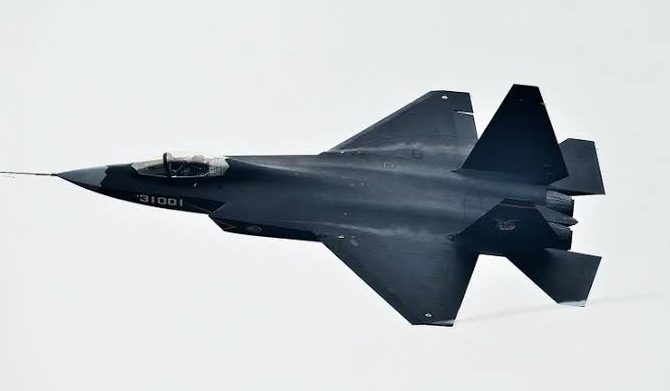India Frantic to Close Negative Gap in Stealth Fighter Domain

Earlier this year, Chief of the Air Staff Air Chief Marshal Zaheer Ahmed Babar Sidhu announced the plan to acquire a fifth-generation stealth fighter from China, affirming that the objective would be achieved in the very near future.
The J-31 Gyrfalcon stealth fighter is poised to be a game-changer and would make Pakistan the first country in South Asia to have a fifth-generation aircraft. This strategic move by the Pakistan Armed Forces to bolster Pakistan Air Force’s fleet with the J-31 sent shockwaves across India, leaving the country in a panic to secure funding for its claimed fifth-generation Advanced Medium Combat Aircraft (AMCA) project.
The approval for the design and manufacturing of AMCA was accorded recently and $1.9 billion were allocated for the development and production of the prototype in the next 5 years. The AMCA programme finalised its basic design configuration in 2015 but momentum on the project has been slow. This tortoise progress is due to bureaucratic and technical hurdles.
The J-31’s prototype held its maiden flight on 31 October 2012. An improved prototype, featuring modifications to various elements including vertical stabilisers, wings, and airframe, alongside enhancements in stealth, electronics, and payload capacity, took to the skies for its maiden flight in December 2016. Pakistan is most likely to get its J-31 delivery by 2026.
Therefore, keeping the AMCA’s schedule in mind, the maiden flight of its prototype cannot be expected soon. Neutral defence experts suggest that the first flight may not occur until 6 to 7 years, with serial production likely commencing in 2035. Consequently, operational clearance might not be achieved until the year 2038.
J31 vs AMCA
The J-31 has a maximum speed of Mach 1.8. The aircraft can operate at altitudes up to 16,000 metres. It is powered by two RD-93 afterburning turbofan engines (soon to be upgraded to WS-19) contributing to its impressive thrust capabilities. In terms of combat range, the J-31 can cover approximately 1,250 kilometres on internal fuel alone and up to 1,900 kilometres with aerial refuelling. Additionally, its weaponry includes a variety of air-to-air and air-to-ground munitions, carried on six external and internal hardpoints with a combined capacity of up to 8,000 kilograms.
The AMCA is expected to achieve a top speed of around Mach 2.15. Its operational ceiling is projected to reach altitudes of up to 20,000 metres. The AMCA is envisaged to be powered by GE F414 engine. The fighter plans to incorporate an indigenous GTRE K9 or K10 engine later. In terms of combat range, the AMCA is expected to have a range of approximately 3,240 kilometres. Additionally, the aircraft will be equipped with a versatile array of weaponry, including air-to-air missiles, air-to-ground missiles, and precisionguided munitions. It has a payload capacity of 6,500 kilograms. It also has 14 external hard points, however, the details of the internal and external carriage combinations are not yet known.
Stealth Capabilities
The J-31 Gyrfalcon, with its rectangular shape and S-shaped air intakes, prioritises radar evasion and internal weapons storage. In contrast, the AMCA features an angular design with shoulder-mounted wings and a stabilator V-tail. Stealth capabilities are a crucial aspect of fifth-generation fighters, and J-31 emerges as the frontrunner in this domain. The J-31 achieves this through its twin-tail layout and serrated edges, while the AMCA utilises diverterless supersonic inlets and a distributed passive sensor system.
While rigorous testing has validated the J-31’s stealth features for the past 8 years, the AMCA’s stealth assessment is slated to commence 2029 approximately. Without any bias, granting all the advantages to India, Pakistan has outpaced it by a minimum of 8 to 10 years in the stealth domain.
Today, India faces a complex challenge in the stealth domain with a negative gap. The anticipated timeline of AMCA encounters obstacles, primarily concerning the “Make in India” aspect. The emergence of stealth aircraft in Pakistan, particularly the J-31, will add to the IAF’s concerns. Once operationalised, the alignment of the J-31 with existing data links and avionics promises seamless integration into the PAF’s fleet, elevating Pakistan’s aerial defence to new heights. Response strategies for India include acquiring F-35s or exploring alternatives, however, each will now have implications for the IAF. The likelihood of the IAF opting for over-the-counter procurement exacerbates urgency from Indians to counterbalance Pakistan’s impending acquisition of the fifth-generation fighter.
However, it will take the Indians a minimum of 6 years for an alternate option, and that too if the process commences now. A well done to the Armed Forces’ leadership for checkmating its adversary and taking a lead in the technological realm.


